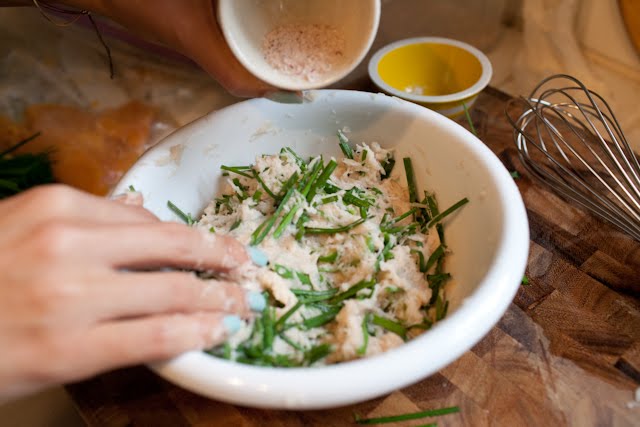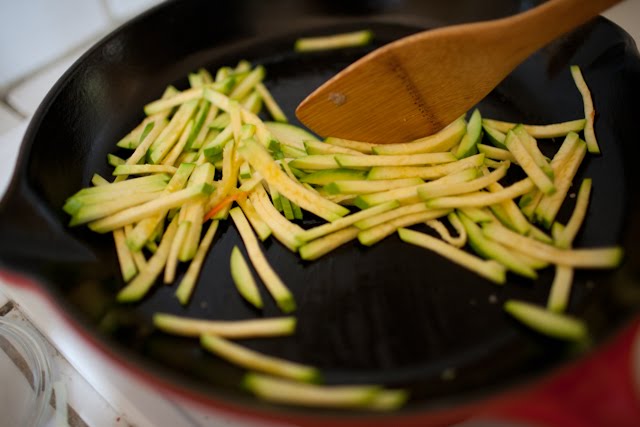If you are Korean you may have some fond memories of getting hungry in the middle of the night and mixing up a bowl of rice with whatever banchan(side dishes) you can find sitting in the fridge. This is what bibimbap is essentially. Just mix rice, side dishes, some red pepper paste, sesame oil, an egg and you're done. It's one of the most popular dishes in Korea and also why we love to fly Korean Air. (They serve bibimbap and it beats any other kind of airplane food hands down.)
Here we will be making a typical version from scratch. But again, there are no rules. You can change what goes in it.
Ingredients:
1 carrot sliced into match sticks
1/2 large zucchini sliced in to matchsticks
1 handful of shittake mushrooms sliced
1/2 bunch spinach
1/3 daikon sliced into matchsticks
2 oz of thinly sliced brisket (rib eye is also good. buy the meat that is sliced for shabu shabu. If you don't have an Asian market you can slice it thinly yourself by freezing the meat for 30 minutes)
Minced garlic
1 T soy sauce
1 t rice wine
Salt
Pepper
Sesame oil
Seasame seeds
Cooking oil
2 bowls cooked rice
2 eggs sunny side up
Sauce:
3 T red pepper paste
1 t plum extract
1 t sesame oil
1 t sesame seeds
1 T Korean cooking syrup (oligodang)
1 t vinegar (we used apple cider vinegar)

1. Slice the meet into small pieces. In a bowl add the meat, 1 T soy sauce, 1 t minced garlic, 1/2 t sugar, 1t rice wine, 1/2 t sesame oil, 1/2 sesame seeds, salt and pepper. Mix and let marinate.
2. Bring a pot of water to boil. Add the daikon and boil for 5 minutes until slightly tender. Take them out and drain under cold water. Set aside. In the same pot of water add the spinach and blanche for 1-2 minutes. Drain under cold water and set aside.
3. In a bowl, add the spinach, 1/2 t minced garlic, 1/4 t salt, 1/2 t sesame oil and mix well.

4. Heat up a frying pan and add the daikon matchsticks along with 1/2 t minced garlic, salt and pepper. Fry until tender and transluscent. Set aside.
5. In the same pan add some oil, mushrooms, sesame seeds, salt and pepper. Fry for a few minutes until soft. Set aside.
6. In the same pan add the zucchini with salt and pepper. Fry for a few minutes until soft. Set aside.
7. In the same pan add some more oil (if necessary), the carrots, salt and pepper. Fry until soft. Set aside.
8. Finally, add the marinated meat and fry until cooked through.
Here is a picture of all the toppings we just made. Kind of reminds us of japchae toppings.
9. In a small bowl, add all the sauce ingredients and mix well.
To serve, put rice in a large bowl and arrange the toppings. Add the egg and sauce. You can also add crushed seasoned seaweed for garnish. This took us over an hour to make but if you have Korean leftovers in the fridge it might only take you 10 minutes.
Enjoy!
 I found these old school stainless steel lunchboxes a couple years ago at a garage sale and couldn't resist. Brings back memories of Korea, picnics, Mom. All that good stuff.
I found these old school stainless steel lunchboxes a couple years ago at a garage sale and couldn't resist. Brings back memories of Korea, picnics, Mom. All that good stuff. Banchan 1: Lotus Root
Banchan 1: Lotus Root Banchan 2: Stir Fried Anchovy
Banchan 2: Stir Fried Anchovy Banchan 3: Fried Kimchi. It's super easy. Just heat a spoon of oil in a pan. Add a 1/2 cup of chopped kimchi and 1/2 t sugar. Fry until the oil in pan is bright orange and kimchi is soft, around 5 min.
Banchan 3: Fried Kimchi. It's super easy. Just heat a spoon of oil in a pan. Add a 1/2 cup of chopped kimchi and 1/2 t sugar. Fry until the oil in pan is bright orange and kimchi is soft, around 5 min. Shake it up like they make you do at Konghodong. Or just mix it around with your chopsticks and voila you have a lovely lunch. Oh and the bohjagi can double as a table cloth.
Shake it up like they make you do at Konghodong. Or just mix it around with your chopsticks and voila you have a lovely lunch. Oh and the bohjagi can double as a table cloth. 



















































